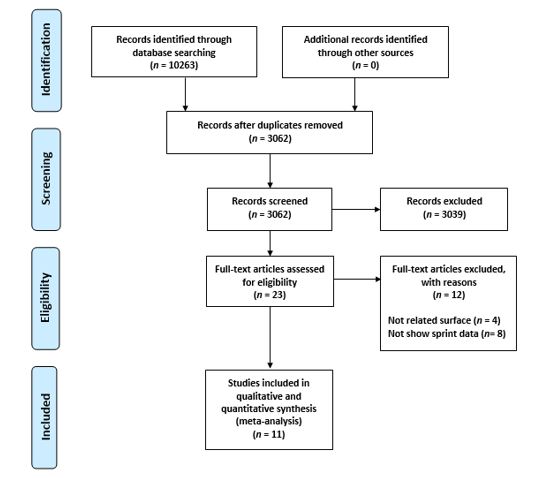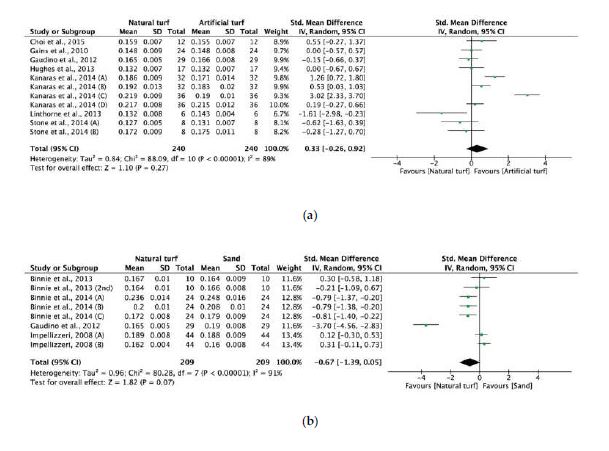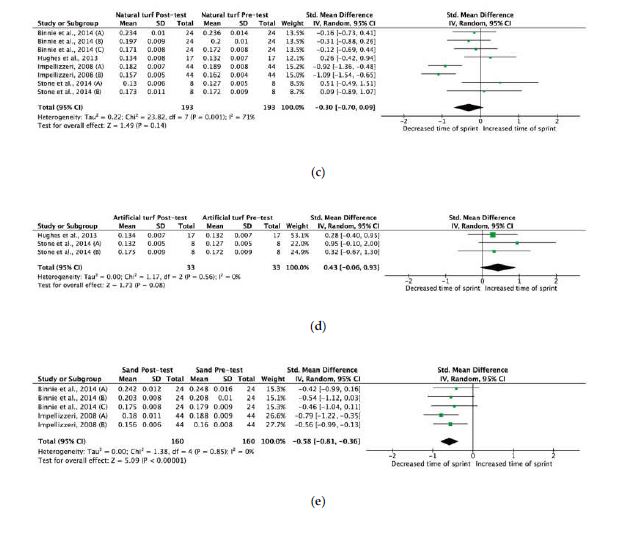The main function of a sport surface is to ensure safety and adequate player performance during physical exercise practice.
- Speed
- Fatigue
- Artificial Turf
- Natural Turf
- Sand
- Performance Anlysis
1. Introduction
One of the most important goals in sport surface construction is to improve sport performance [2]. The constant improvement of sport surfaces like artificial turf is motivated by the demands of the sport sector, as the quality of sport surfaces is considered a determining factor for achieving results [3]. It has been suggested that changes in sport surfaces can have effects on performance patterns and athlete injury [4]. Various studies have proven a relation between the elasticity of a sport surface and athletes’ performance [5].
Research on injury risk has shown contradictory results, although in general, the risk of injury appears to be equivalent on artificial turf and natural grass [6][7]. On the other hand, Plaza-Carmona et al. [8] have shown that bone mass is not affected by practicing football on natural or on artificial turf. Other studies have focused on biomechanical aspects. Alcaraz et al. [9] analyzed running speed kinetics on sand and on an athletic track, finding significant differences in players’ biomechanics. Previous researches have provided information on the influence of the structural components of artificial turf on its mechanical properties, like the study by Sánchez-Sánchez et al. [10], in which it was observed that a compact gravel sub-base extended surface durability, with adequate security parameters.
Likewise, exercise on soft surfaces, like sand, is associated with higher energy expenditure and lower stimulus in impact training than on hard surfaces [11][12][13]. Brito et al. [14] measured higher levels of lactate and increased heart rate in football players during a simulated match on sand compared to artificial turf and hard surfaces. Other studies recommend sand as a training surface for improving neuromuscular adaptations [12][15]. In volleyball players, vertical jump was higher on a hard surface than on a soft surface [16][17].
Another common sport activity analyzed on different sport surfaces is sprint. It has been proven that the high absorption that occurs on sand surfaces limits the maximum speed [11][18]. Therefore, physical performance in sprint and jumping actions is influenced by traction, rigidity, and force reduction of the surface [19]. Studies like the one by Brechue et al. [20] analyzed the differences in speed during sprints on sand and on the track, showing a significant speed reduction on sand. However, no significant differences have been demonstrated in speed on artificial and natural turf, except when the sprinting action includes changes in direction, in which case, speed is higher on artificial turf [21]. Despite this, controversy exists, as the physiological demands of sprint on artificial and natural turf were found to be similar in some studies [22] or higher on natural surfaces in other works [23].
2. The Effect of Different Surfaces on Sprint Speed in Athletes
This study was completed in accordance to the Preferred Reporting Items for Systematic reviews and Meta-Analyses (PRISMA) guidelines [24]. A search strategy was developed to identify all relevant studies assessing the effect of different surfaces on sprint speed in athletes. The search was registered in PROSPERO. Our systematic search was conducted in different online databases: PubMed (whole database), SPORTDiscus, and Web of Science (whole database), since their inceptions until 17 March 2020. The terms used in the search of the databases were: (‘soccer’ OR ‘football’ OR ‘rugby’ OR ‘hockey’ OR ‘netball’) AND (performance OR assessment OR sprint OR speed) AND (‘artificial turf’ OR ‘synthetic’ OR ‘natural’ OR ‘grass’ OR ‘sand’ OR ‘playing surface’ OR field).

Figure 1. Flow diagram of the study.
3. Potential Bias


Figure 4. Standardized mean difference (SMD) between sprint time in: a) natural vs. artificial turf; b) natural turf vs. sand; c) natural turf pre- and post- sprint time assessment with different training methods; d) artificial turf pre- and post- sprint time assessment with different training methods; e) sand turf pre- and post- sprint time assessment with different training methods. Square represent the SMD for each trial. Diamonds represent the pooled SMD across trials.
4. Conclusion
In conclusion, the playing surface is a determining variable affecting the performance of sprint. Thanks to their qualitative improvement, artificial-turf pitches are similar to those in natural turf as regards their effect on sprint speed. The high impact absorption of sand represents the main factor deteriorating sprint performance. Despite this, sand surfaces do not prevent improvements.
As for the limitations, of this study the high heterogeneity of the results observed when comparing different surfaces may be due to the limited time available to produce force during sprint on each surface. Other meta-analyses have shown high heterogeneity of results when different methods were compared [25].
Future research must include control variables to determine the effects of the structural characteristics of artificial- and natural-turf pitches, as well as their mechanical properties. However, the results of this meta-analysis do not show performance differences, in the case of sprint speed. In fact, the results show a better performance on artificial turf in some sub-groups. Previous studies showed that artificial turf also does not cause more injuries and can even reduce them [26]. Therefore, even though the effect of artificial turf on speed could in principle affect a game result, until now, scientific investigation suggests that it is an ideal surface to substitute natural turf in unfavorable economic situations or adverse climates, without negative repercussions on sprint performances
This entry is adapted from the peer-reviewed paper 10.3390/ijerph17249478
References
- Fleming, P. Artificial turf systems for sport surfaces: Current knowledge and research needs. J. Sports Eng. Technol. 2011, 225, 43–63.
- Baroud, G.; Nigg, B.; Stefanyshyn, D. Energy storage and return in sport surfaces. Sports Eng. 1999, 2, 173–180.
- Gallardo-Guerrero, L.; García-Tascón, M.; Burillo-Naranjo, P. New sports management software: A needs analysis by a panel of Spanish experts. J. Inf. Manag. 2008, 28, 235–245.
- Ekstrand, J.; Nigg, B.M. Surface-related injuries in soccer. Sports Med. 1989, 8, 56–62.
- Katkat, D.; Bulut, Y.; Demir, M.; Akar, S. Effects of different sport surfaces on muscle performance. Biol. Sport. 2009, 26, 285–296.
- Ekstrand, J.; Timpka, T.; Hägglund, M.; Karlsson, J. Risk of injury in elite football played on artificial turf versus natural grass: A prospective two-cohort study. Br. J. Sports Med. 2006, 40, 975–980.
- Fuller, C.W.; Dick, R.W.; Corlette, J.; Schmalz, R. Comparison of the incidence, nature and cause of injuries sustained on grass and new generation artificial turf by male and female football players. Part 1: Match injuries. Br. J. Sports Med. 2007, 41, 20–26.
- Plaza-Carmona, M.; Vicente-Rodríguez, G.; Martin-Garcia, M.; Burillo, P.; Felipe, J.L.; Mata, E.; Casajús, J.; Gallardo, L.; Ara, I. Influence of hard vs. soft ground surfaces on bone accretion in prepubertal footballers. Int. J. Sports Med. 2014, 35, 55–61.
- Alcaraz, P.E.; Palao, J.M.; Elvira, J.L.; Linthorne, N.P. Effects of a sand running surface on the kinematics of sprinting at maximum velocity. Biol. Sport. 2011, 28, 95–100.
- Sánchez-Sánchez, J.; Felipe, J.L.; Burillo, P.; Del Corral, J.; Gallardo, L. Effect of the structural components of support on the loss of mechanical properties of football fields of artificial turf. J. Sports Eng. Technol. 2014, 228, 155–164.
- Gaudino, P.; Gaudino, C.; Alberti, G.; Minetti, A.E. Biomechanics and predicted energetics of sprinting on sand: Hints for soccer training. J. Sci. Med. Sport 2013, 16, 271–275.
- Impellizzeri, F.M.; Rampinini, E.; Castagna, C.; Martino, F.; Fiorini, S.; Wisloff, U. Effect of plyometric training on sand versus grass on muscle soreness and jumping and sprinting ability in soccer players. Br. J. Sports Med. 2008, 42, 42–46.
- Zamparo, P.; Perini, R.; Orizio, C.; Sacher, M.; Ferretti, G. The energy cost of walking or running on sand. Eur. J. Appl. Physiol. 1992, 65, 183–187.
- Brito, J.; Krustrup, P.; Rebelo, A. The influence of the playing surface on the exercise intensity of small-sided recreational soccer games. Hum. Mov. Sci. 2012, 31, 946–956.
- Mirzaei, B.; Norasteh, A.A.; Asadi, A. Neuromuscular adaptations to plyometric training: Depth jump vs. countermovement jump on sand. Sport Sci. Heal. 2013, 9, 145–149.
- Bishop, D. A comparison between land and sand-based tests for beach volleyball assessment. J. sports Med. Phys. Fit. 2003, 43, 418–423.
- Muramatsu, S.; Fukudome, A.; Miyama, M.; Arimoto, M.; Kijima, A. Energy expenditure in maximal jumps on sand. J. Physiol. Anthropol. 2006, 25, 59–61.
- Binnie, M.J.; Peeling, P.; Pinnington, H.; Landers, G.; Dawson, B. Effect of surface-specific training on 20-m sprint performance on sand and grass surfaces. J Strength Cond. Res. 2013, 27, 3515–3520.
- Sánchez-Sánchez, J.; García-Unanue, J.; Jiménez-Reyes, P.; Gallardo, A.; Burillo, P.; Felipe, J.L.; Gallardo, L. Influence of the mechanical properties of third-generation artificial turf systems on soccer players’ physiological and physical performance and their perceptions. PLoS ONE 2014, 9, e111368.
- Brechue, W.F.; Mayhew, J.L.; Piper, F.C. Equipment and running surface alter sprint performance of college football players. J. Strength Cond. Res. 2005, 19, 821.
- Gains, G.L.; Swedenhjelm, A.N.; Mayhew, J.L.; Bird, H.M.; Houser, J.J. Comparison of speed and agility performance of college football players on field turf and natural grass. J. Strength Cond. Res. 2010, 24, 2613–2617.
- Sassi, A.; Stefanescu, A.; Menaspà, P.; Bosio, A.; Riggio, M.; Rampinini, E. The cost of running on natural grass and artificial turf surfaces. J. Strength Cond. Res. 2011, 25, 606–611.
- Di Michele, R.; Di Renzo, A.M.; Ammazzalorso, S.; Merni, F. Comparison of physiological responses to an incremental running test on treadmill, natural grass, and synthetic turf in young soccer players. J. Strength Cond. Res. 2009, 23, 939–945.
- Maher, C.G.; Sherrington, C.; Herbert, R.D.; Moseley, A.M.; Elkins, M. Reliability of the PEDro scale for rating quality of randomized controlled trials. Phys. Ther. 2003, 83, 713–721.
- Katsanos, K.; Kitrou, P.; Spiliopoulos, S.; Maroulis, I.; Petsas, T.; Karnabatidis, D. Comparative effectiveness of different transarterial embolization therapies alone or in combination with local ablative or adjuvant systemic treatments for unresectable hepatocellular carcinoma: A network meta-analysis of randomized controlled trials. PLoS ONE 2017, 12, e0184597.
- Williams, S.; Hume, P.; Kara, S. A review of football injuries on third and fourth generation artificial turfs compared with natural turf. Sports Med. 2011, 41, 903–923.
